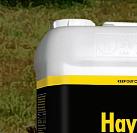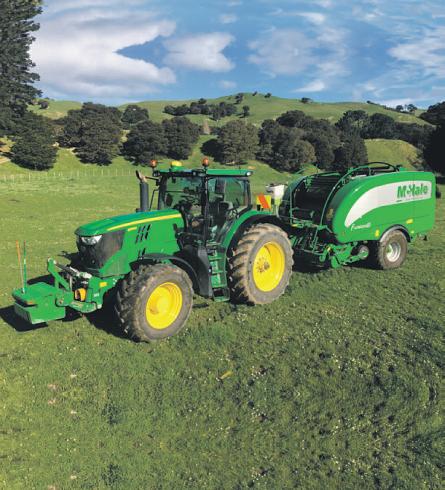





















































































Good animal performance dependsonthe adequate intakeofgood quality supplementaryfeed when green pastureishardtocome by.Thatmightbeduring aprolonged dryperiod or when the growth of grass has slowedduring winter.
Silage,balage and hayare made from excess grass,and form the basis of most forage-based feeding systems in New Zealand.Thereare other supplementaryfeeds,such as cereal grains and pulses,but these can work out to be very expensive per kg of DryMatter(DM).
A2020 AgResearch WhitePaper on pasture-fedlivestock production and products (citingpreviously published research) has also reportedthat

• Direct Drilling
• MinimumToFullTillage Cultivation
• Maize Planting &SideDressing
• Pasture&CropSpraying • SilageGrass,Cereal &Maize
• Baleage&Hay • Grain&SeedHarvesting
• GrainDrying& Handling
• Cartage
• SupplementaryFeed Trading




supplements can have impacts on the tasteand condition of meatand milk:“feeding brassicas can adversely affectmilk flavour,and palm kernel expeller contains fats thatlower the melting pointofmilkfatand contributetooverlysoftbutter.”So forage-based feeding systems are preferred, although JarrodBooker from AgResearch says that“the effects of differentfeeds on product flavour can be subtle”.
Back to drymatter-essentially, DM is the plantmaterial that remains aftermoisturehas been removed. It’s sometimes described as acomprehensivecocktailof proteins,fats, vitamins,minerals,and carbohydrates–all the nutritional goodies animals needtothriveand be productive.
Getting enough DM is important. TheScienceLearning Hub says that“adairycow at the peak of her production consumes around 18kg of DM (around 100 kg of fresh pasture weight) per day. Aewe with asingle lamb consumes 2–3 kg of DM per day”
So whatissilage and howmuchDM does it contain? Silage is pasture grass thathas been‘pickled’- a method used to preservethe pasture
during the grass-growing months, forcowsand sheep to eatlater when natural pastureisn’t available. The grasses arecut and then fermented (or ensiled) to keep as much of the nutrients such as sugarsand proteins as possible. Thefermentation iscarried out by microscopic organisms living in the grass
Balageissimply silage wrappedin aplastic bag instead of being kept in big coveredpits or stacks.Balage is muchloved by manylifestyle blockers.The bags keep out the air, which would otherwise spoil silage, ensureaqualityproduct, and are convenientfor storing and feeding out
Matt andLauran McLennan ownWoodlea Contracting Ltd, aDalefield-based agri-business focused on the contracting needsof lifestyleblocks.Laurasaysthatsilage made from pasturegrass is agreat supplementfor cows thatare calving towardsthe end of winterand horses starting to foal from October “Itprovides extraprotein and extra calories.”
According to DairyNZ,when makingsilage,the aim is to cut at 16-20% DM and preserve at 30-35% forgeneral silage or 35-40%



forbaled.You canbuy apieceof equipmentthatmeasures moisture, or samples can be sentawayfor analysis.Alternatively,experienced contractors like Matt and Laura can tell by the ‘look and feel’whether the moisturecontent is about right. Feed quality, oftenquantifiedas metabolisable energy per kilogram of drymatter(M/D)isascrucial as feed quantity(the amountofDM). A high M/D value meansbetter feed as it has more usableenergy.DairyNZ says that:
SILAGE should contain between 9and 10 M/D,with anitrogen contentbetween 2.4 and 2.7% of DM.
HAY should contain 8to9 M/D, withthe nitrogen contentat between 1.1 to 2.7% of the DM.
Haybales have the advantage of being easier to storeand to feed out.Ifyou’remaking hay, the advice is to bale it when dryand keep it undercoverorsell to someone straightoffthe paddock,because damp haydoesn’t keep and damp bales in ashed can catchfire
Matt and Laura areclient-focused when it comes to the DM of silage and hay. “One of our clients with




horses likes the hayparticularly dry,”Laurasays, “which we can accommodate.”
Matt is alocal Wairarapian,brought up on aDalefield dairyfarm, and with apassion forfarmingsincehe wasyoung.Hemet Guernsey-born Lauraatthe TopPub in Greytown at Christmas 2016 while dressed in areindeer onesie,but she clearly didn’t holdthatagainst him.
Afterworking forGray’sContracting formanyyears,Mattestablished Woodlea Contracting to filla gap in the contracting market: lifestyle blocks
Woodlea makes silage and hayfor their home farm,for lifestyle block clients,and to sell in winter. With multiple tractors,balers,and minibaler machines,the couple arewell set-up.Inthe down months,Matt does fencingand other land-based work
ContactMatt and Laura through facebookwww.facebook. com/woodleacontracting, via email at woodleacontracting @hotmail.com, or on 027 284 7543.























Lots has been written about howtomakesilage and there’s quitea bitofsciencetoit. In brief,however,the idea is to:
Cutthe grass in the morningona sunnyday,for rapid wilting.Cutting after1-2 days of sunnyweather will result in good sugar levels in the pasture, even whencut in the morning.Avoid wilting forany morethan 24 hours. Afast wilt to
25-30% DM willleave good sugar concentrations in the pasture.
Compactthe silage well.Inastack or pit,use the heaviest wheeled vehicle available.For baled silage makesurethatahigh densitybaler is used
Seal the stack completely with aweighted, airtightcover.Wash old polythene beforeuse to avoid contamination with the wrong bacteria.






Quick compaction and effective sealingwill keep out oxygen, making conditions moresuitable forbacteriatoconvert sugars into lactic acid (pickling or ensiling). Fast production of lactic acid helps preventprotein losses.This ensures the silage can be preserved forextended lengths of timefor feeding out in times of feed deficit, without losses in feed quality.

Thestorage of silage is very important, to ensurenoloss in feed quality. Advice on storage,ifyou’vechosen pit or stack storage over balage options,istocreate easily accessible storage that is at least 50 metres away from waterways,open dams or drains, or the catchmentareas of bores.Thatdistancemightneed to be further if the land is steep or soils are coarse textured.Silage leachate should never enterwaterways as it is highly toxic to aquatic life.




Foundation for Arable Researchhas reported that losses in silage stacks and at open silage faces canbeas much as 40%”
activating beneficial lactic acid and acetic bacteria, both of which occur naturally on the forage) and reduces the action of spoilage microbes
“Wedeveloped our SilageKing product directly with contractors and farmers to make it easy to use on-farm. Youapply SilageKing straightfromthe drum so it doesn’t need to be diluted beforeuse,” Jerome says.“Theproducts arestable at room temperatureand onceyou open acontainer youcan use the remaining productatalater date,thereby reducing wastage.Our products arecost competitiveand we also offer certified organic products.All our products are made in New Zealand.”
SilageKing also inhibitsthe growth of yeasts (which heatupsilage pit faces) and spoilage fungi(some of which producemycotoxins thatimpair animal weightgain and fertility). “Cowsdon’t like eating silage thathas heatedup,” Jerome says.“and by reducing the activity of yeasts youmaintain the energy contentofthe silage.”SilageKing helps farmers and contractors reduce the risks and costs associatedwith silage spoilage
Storage is best,too,awayfromgullies or other places whererun-off catchment water could flowintothe storage area. Thesilage bunker floor should be watertight andextend outbeyondthe bunker walls.Stacks of silage need to be properly coveredtokeepthe oxygen out.Preventing rainwater entering is crucialtoreducethe volume of leachate.
New Zealand’s Foundation forArable Research (FAR) has reportedthatlosses in silage stacks and at open silage faces (through aerobic deterioration) can
be as much as 40%. Andinthe case of bales,one slit in the plastic sheath can ruin the entirebale. However, modernsilage preservationenhancers and inoculants can improvesilage preservationand avoidsilage spoilage JeromeDemmer,CEO of New Zealand companyBiostartisclear about the advantages of Biostart’sproducts for biological farming solutions.Jerome talks about their productcalled ‘SilageKing’which increases the action of ensiling microbes in silage (by
Wairarapa agri-businesses Colton Bros LtdinMartinborough, and Gray’s Contracting andScott’s Ag Contracting from Carterton, have each provided public testimonials to supportthe Biostartproducts.Mattand Laurafrom Woodlea Contracting areanother local and satisfiedSilageKing customer.“We can be certain of the preservation and qualityofour silage,”says Laura. www.biostart.co.nz 0800 116 229 info@biostart.co.nz


















Hayisthe result of alot of months of work -including spraying,ploughing, sowing,fertilising,and praying for the rightamountofrain or irrigated water -not toolittle,not toomuch. Andthen there’sthe cuttingand baling thatgenerally takes placebetween December and February.
Afterall that, you’ll want to look after your hay. Much like anyforage crop,hay is pronetoDMlosses and deterioration ofquality while in storage. Protecthay bales against deterioration by storing them under shelter and away from the elements or anywater runoff.Ifahay shed is not available, alternatives such aswrapping orcovering withatarpare advised
If bales arenot protectedagainst moisture and theelements,mould growth and spoilage will occur in your bales over time Do not sit bales directly onto baresoil, put down atarpfirst to preventwater wickingintoyour bales.And ensurethere is sufficientairflowaround your bales to preventmoisturebecomingtrapped and causing mould growth
Biostart’shay preservative, HayKing, keeps bales cooler afterbaling by inhibiting the growth of spoilage microbes.The spoilage microbes use up energy in the haytoproduceheat, and some alsoproducemycotoxins that adversely affectanimal health. Biostart’s CEOJerome Demmer says that“HayKing createshigh-qualitybales even when baling at highermoisturelevels”.
It’sall about the weather
NIWA’sseasonal outlook forWairarapa indicates thatinthe months to the end of 2024:
La Niña-likepatterns mightdevelop, favouring the returnof higher than normal air pressure.
Temperatures will be above average.
Rainfall will be near or belownormal
Soil moisturelevels will be near normal.
Riverflowswill be near or belownormal.
Because snowfall, catchment-levelriver flows,and groundwater recharge were below normal during winter, challenging conditions could be ahead for water-reliantsectors.








Andrew Olsen, CEO of Rural Contractors NewZealand (RCNZ) since2021, anda Wairarapa residenttoboot,says RCNZ represents about600 agri-contractors and their rural communities on manydifferent issues.One of the hottest issues is the critical need fora sustainable rural workforce.
“The work our agri-contractors are involved in makes ahuge contribution to New Zealand’s GDP.We’re involved in a$1.5 billion industry. Added to which, the government’stalking about doubling primaryexports within 10 years.But we needthe rightworkforce in the rightrural locationsfor thattobe possible,”Andrew says
In our March2024 Wairarapa Rural Outlook feature, the Wairarapa Times-Age found thatrightalong therural workforce pipeline,fromLevel 2toLevel 7, young people have options foragri-training.And yet the numbers accessingagri-training options arelow,and contractors are having to go overseastofind staff Woodlea Contracting,owned by Matt and LauraMcLennan,has had some “awesome”local staff but,more recently,had alocal employeewho did arunner.Their business nowrelies on one excellentfull time local,aswell as someone from aDutch agency, and another worker from aUK agency.


Andrew Olsen says thatthe rural sector and the governmentknowwhatthe problems are. “The pathway from school to theworkforce is just not strong enough and not attractiveenough.”
Andrew waspleased to hear about Wairarapa primary andintermediate schools leaning into the rural sector through the ‘Famer Time forSchools’ programme, profiledrecently in our September 2024 Wairarapa Rural Outlook.And manyWairarapa colleges maintain school farms and offer agricultural training



RCNZ has worked with the developer of the HanzonJobsApp which allows trainees in the agri-contracting sectorto record all their differing tasks,providing acomprehensivesummaryfor the worker and employers.The Appwas used in judging the RCNZ Trainee of the Year in 2023, won by 25 year old Jessica Bills who grew up in Pahiatua and worked forlocal companyMabey Contracting
But Andrew says that,“New Zealand needs more.Weneed ajoined-up workforce planfor therural sector

embedded in the MinistryofEducation’s curriculum rightfromprimaryschool.In the meantime,there’spressure on agricontractors who must meet the needs of the farmers when the weather is right. Fatigue is becoming an issue. It shouldn’t be this hardfor our rural sectortomeet the demands of exportmarkets.”
He’s laid down achallenge forall the relevantgovernmentagencies to join up with along-termrural workforce pipeline,but also to finda waytofill in the gaps in the meantime












We are100% NewZealand owned and operated Allofour productsare produced from all-natural limestone, quarried right here in Wairarapa We don’tuse unnecessary additives or chemicals and offer bothorganicand non-organicoptions










